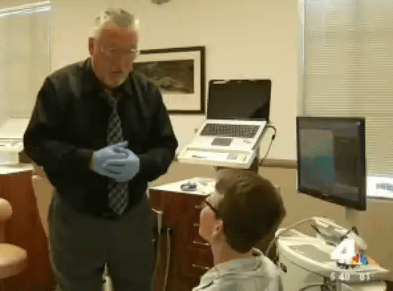
Dr. Mitchell works with a patient who has special needs.
For many kids, braces are a rite of passage – not an enjoyable one, but worth enduring for straight teeth and a lovely smile. For children with special needs, however, braces can be more than a nuisance.
Children on the autism spectrum, and those with cerebral palsy and other challenges, are extra sensitive to having wires and brackets in the mouth and often damage the appliances. Traditional braces also make oral hygiene – already a challenge for children with special needs – exceptionally difficult. “Typical wires and braces are irritants and food collectors,” says Ken Fischer, DDS, (www.kenfischerorthodontics.com) an orthodontist who practices in Villa Park. “The kids tend to play with them and manipulate them.”
The challenge of treating children with special needs can cause orthodontists to shy away from taking these patients. “There is a mindset in many orthodontists that these are untreatable situations,” says Fischer, who has been in practice 38 years. Still, Fischer finds that parents of children with special needs, like all parents, want to do all they can for their kids, including having their teeth straightened. And he says it is a myth that these children aren’t interested in how they look. “I’ve seen these kids become noticeably excited about seeing their straight teeth,” he says.
About seven years ago, Fischer found a solution: clear aligners, often known by the brand name Invisalign. These removable trays are easier for children with special needs to tolerate, because they are fabricated for a close fit to the child’s teeth and they are smooth. “When they are on, there is nothing really even noticeable,” says Fischer. And because the aligners are removable, they make it easier to keep kids’ teeth clean.
Clear aligners won’t work on all types of orthodontic problems, but can be used to correct many. Many orthodontists now use them, but Fischer says there are other requirements for success in treating kids with special needs. “You still have to have a high degree of empathy for these kids in working with them,” he explains.
His suggested questions for prospective orthodontists:
- Do you work with clear aligners?
- Are you otherwise equipped to treat a child with special needs? For instance, if a child uses a wheelchair and cannot transfer to a dental chair, can you still treat the child?
- Do you have digital scanners for use in fabricating the appliance? Children with special needs often can’t tolerate traditional dental impressions, which require them to hold bulky trays in the mouth for several minutes. Digital scanners can provide the same information in a non-intrusive way.
- Do you feel comfortable working with a child with special needs?
Fischer says that clear aligners tend to cost marginally more than traditional braces, but that insurance that covers orthodonture will likely cover clear aligners. He reminds parents that orthodontic treatment is a long-term process requiring repeat visits. It also requires some home care, as parents will likely have to help their child insert and remove the trays, and also help them clean the trays and their teeth. Still, they put orthodontic treatment within the realm of possibility.
“When most people think of orthodonture, they still think of wires and braces,” Fischer says. “These parents think, Oh, my child could never handle that.” Clear aligners could give them something to smile about.
Christina Elston is Editor of L.A. Parent.























